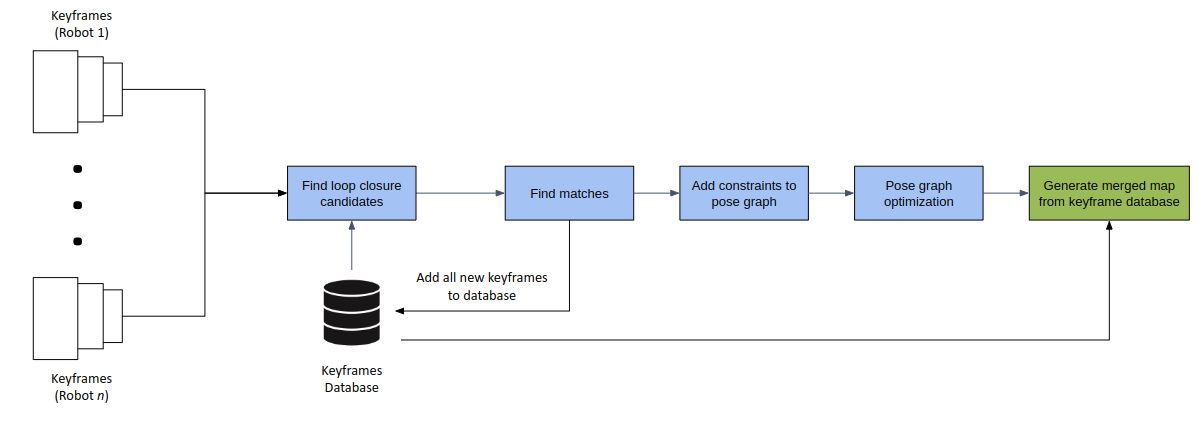elastic_map_merge_3d is a ROS package for merging multiple 3D point cloud maps through keyframe loop detection process. This package aims to improve upon existing rigid map-merging processes, which typically take the entire 3D point cloud map from each robot in the multi session and attempt to merge them together by applying a rigid transform. However, such rigid map-merging processes usually suffer from distortions as certain parts of the map fail to align properly. Hence, elastic_map_merge_3d aims to address this issue by merging maps through a less rigid keyframe loop detection based method.
As elastic_map_merge_3d merges 3D point clouds through a keyframe loop detection process, a 3D SLAM algorithm that can output keyframe messages is required. A modified version of hdl_graph_slam has been created to output keyframe messages for the map-merger process. Download and install the modified hdl_graph_slam package according to the repository instructions here:
Note that if you want to perform map-merging in real-time on actual robots, then hdl_graph_slam needs to be installed on each individual robot involved.
The following ROS packages are required for elastic_map_merge_3d package:
The package is released for ROS Melodic. Build it through catkin_make process. git clone it to your catkin_ws/src folder. After that, build the package through catkin_make
cd ~/catkin_ws/src
git clone https://github.com/leonardlohky/elastic_map_merge_3d
cd ..
catkin_make
The map merger process is based on keyframe matching, and generates the merged map subsequently from the keyframes stored in its database.
First, the map merger package attempts to locate robots that are involved in the multi-mapping session based on a given prefix namespace (e.g. robot_0). Upon discovery of new robots, the package subscribes to the robot's keyframe topic, which contains all the local keyframes for that particular robot. The keyframe topic is published by the hdl_graph_slam package, and each keyframe contains the following data:
| Parameter Name | Meaning | Type |
|---|---|---|
| robot_ns | Robot namespace | string |
| pose | Pose information of the keyframe | geometry_msgs/Pose |
| accum_distance | Accumulated travel distance | float64 |
| cloud | Keyframe pointcloud | sensor_msgs/PointCloud2 |
| floor_coeffs | Floor coefficients defining the floor plane for the keyframe | float64[4] |
After that, the map merger will periodically check the keyframe topic of each robot and see if there are new keyframes that have not been processed. If so, it will initiate a pose node in the pose graph and add a constraint between the last latest subsequent keyframe with the same robot_ns entry. For example, if the current keyframe has a robot_ns of "robot_01", the package will search through its database to find the latest keyframe with the same robot_ns of "robot_01" and add a constraint between the two.
Following that, each new keyframe will then be processed to find if they are a potential loop closure candidate based on several threshold checks. Identified candidates will then be compared against each stored keyframe in the system's database via pointcloud matching. If the matching score passes the set fitness score threshold, it is postively identified as a loop closure instance. The relative pose between the matching keyframes is obtained to act as a new constraint and added the pose graph. Once all new keyframes have been processed, pose graph optimization is done.
Finally, to get the merged map, it takes a snapshot of the updated keyframe database and joins up all the keyframes as one single merged pointcloud. This merged pointcloud is then published as a topic to ROS.
The map merger process used for this package is illustrated below:

A template launch file can be found under launch/elastic_map_merge.launch, modify it accordingly to suit the application. Some important parameters that need to be set to ensure that the elastic_map_merge_3d package can automatically find multiple robots and their respective keyframe topics includes the following:
| Parameter Name | Meaning | Values |
|---|---|---|
| robot_kf_topic | Name of robot keyframe topic without namespaces | string, default: keyframes |
| robot_namespace | Fixed part of the robot keyframe topic. Only topics which contain (anywhere) this string are considered for lookup | string, default: <empty string> |
Create a respective hdl_graph_slam roslaunch file for each robot that will be involved in the multi-session. Examples can be found in the hdl_graph_slam/launch folder, use that as reference to create a suitable launch file for your own robot. Take note of the robot_ns param within the launch file, they should all have a common prefix, e.g. multirobot_0X so that the elastic_map_merge_3d package can automatically find them as detailed in Step 1.
Start the hdl_graph_slam package on each robot through their respective roslaunch files:
# Example
## Robot 1
roslaunch hdl_graph_slam robot_1.launch
## Robot 2
roslaunch hdl_graph_slam robot_2.launch
## etcTo execute the process, simply run the launch file. Remember to source for the workspace if you have not.
roslaunch elastic_map_merge_3d elastic_map_merge.launchThis issue is caused by the g2o_solver_num_iterations parameter under the g2o solver. It appears the higher the number of iterations, the more likely this issue will occur. To fix this, reduce the number of iterations.
Check that the use_floor_information parameter in the launch file is set to false. For some reason, if the map merger uses floor information from the keyframes to add constraints to the pose graph, the maps will not merge even though loop closures are successfully detected. I am not sure as to the reason why map merger will not happen if floor information is used even though it worked for the original hdl_graph_slam package. If anyone manages to figure out the reason, do let me know.
The package is licensed under MIT license
This package loop detection method is based on the one created in the original hdl_graph_slam by koide3.